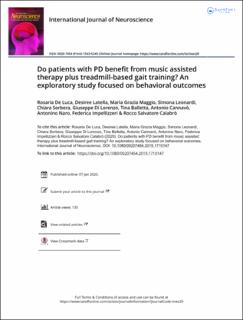| dc.contributor.author | De Luca, Rosaria | |
| dc.contributor.author | Latella, Desiree | |
| dc.contributor.author | Maggio, Maria G. | |
| dc.contributor.author | Leonardi, Simona | |
| dc.contributor.author | Sorbera, Chiara | |
| dc.contributor.author | Di Lorenzo, Giuseppe | |
| dc.contributor.author | Balletta, Tina | |
| dc.contributor.author | Cannavò, Antonio | |
| dc.contributor.author | Naro, Antonino | |
| dc.contributor.author | Impellizzeri, Federica | |
| dc.contributor.author | Calabrò, Rocco S. | |
| dc.date.accessioned | 2020-07-07T13:12:43Z | |
| dc.date.available | 2020-07-07T13:12:43Z | |
| dc.date.issued | 2020 | |
| dc.identifier.citation | De Luca, R., Latella, D., Maggio, M. G., Leonardi, S., Sorbera, C., Di Lorenzo, G., . . . Calabrò, R. S. (2020). Do patients with PD benefit from music assisted therapy plus treadmill-based gait training? An exploratory study focused on behavioral outcomes. International Journal of Neuroscience, 1-8. | en_US |
| dc.identifier.uri | https://hdl.handle.net/11250/2660991 | |
| dc.description.abstract | Purpose: Parkinson’s disease (PD) is the second most common age-related neurodegenerative disorder, presenting not only with motor symptoms (resting tremor, bradykinesia, and muscular rigidity), but also with cognitive and behavioral problems that need to be addressed in a rehabilitation setting. Aim of the study was to evaluate the effects of a combined rehabilitative approach, using gait training coupled to music-based therapy, on cognitive and behavioral function in a sample of patients with PD.
Materials and Methods: Forty patients, meeting the inclusion criteria, were enrolled in this study and were randomly divided into two groups. The control group (CG) underwent traditional over ground gait training, whilst the experimental group (EG) underwent gait training with the Biodex Gait Trainer 3 (a treadmill integrated with music therapy). Each subject was evaluated at baseline (T0) and after the training (T1), using specific neuropsychological and motor function tests.
Results: The EG presented higher outcomes scores concerning mood and quality of life in all subscales of Psychological General Well-Being Index (i.e. anxiety, depression, health, vitality and positivity) and subscales of Brief-COPE, with regard to behavioral disengagement, positive reframing, planning, acceptance and use of emotional support, as compared to the CG. Moreover, a significant improvement in motor functioning, with regard to static and dynamic balance, was found in the EG.
Conclusion: Music-based gait training rehabilitation may be considered an effective strategy to improve behavioral performances, coping strategies and rehabilitation outcomes in patients with PD. | en_US |
| dc.publisher | International Journal of Neuroscience | en_US |
| dc.subject | Parkinson’s disease | en_US |
| dc.subject | music - enhanced treadmill | en_US |
| dc.subject | advanced rehabilitation | en_US |
| dc.subject | Parkinsons sykdom | en_US |
| dc.subject | nevrologiske lidelser | en_US |
| dc.title | Do patients with PD benefit from music assisted therapy plus treadmill-based gait training? An exploratory study focused on behavioral outcomes | en_US |
| dc.type | Journal article | en_US |
| dc.source.pagenumber | 1-8 | en_US |
| dc.source.journal | International Journal of Neuroscience | en_US |
| dc.identifier.doi | https://doi.org/10.1080/00207454.2019.1710147 | |
| dc.description.localcode | måsjekkes | |
